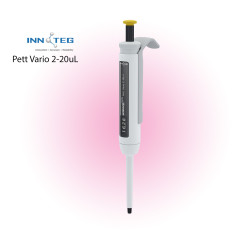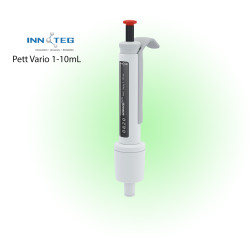
Today we will bring you a guide to the use of —— pipette in laboratory instruments! Whether you are a lab novice researcher or a senior researcher, mastering the correct way to use the pipette is the key to successfully completing the experiment and obtaining accurate results. This guide will introduce the basic structure of the pipette, common problem solutions, and some techniques to make you a master in the lab!

For laboratory research, the important thing is that the experimental error is small, good reproducibility, it is necessary to pay attention to the correct use of pipette.
Tips for extending the pipette life span
● Careful operation: When using the pipette, avoid excessive force or violent vibration, especially when absorbing and distributing the liquid. Soft and smooth operation can reduce the pressure and damage risk to the pipette parts;
● Avoid excessive pressure: follow the maximum and minimum suction volume limits of the pipette, and do not exceed its rated range. Excessive pressure may cause damage to the piston, plunger, or seal of the pipette;
● Regular maintenance: conduct regular maintenance, such as cleaning the pipette, replacing the suction nozzle and filter head, etc. Keeping the pipette clean and pollution-free state helps to extend its life and reduce the occurrence of faults;
● Use the appropriate liquid: select the appropriate liquid according to the specifications and material requirements of the pipette. Avoid the use of corrosive, toxic or excessive liquids to reduce damage to the pipette;
● Follow the instructions: Read and follow the pipette instructions carefully and follow the correct steps and recommendations. Compliance with the instructions can protect the pipettes and reduce unnecessary damage;
● Proper storage: store the pipette in a dry, clean, avoid direct sunlight and high temperature environment. Proper storage helps to maintain the performance of the pipette and extend its service life;
● Periodic calibration: calibrate and verify the pipette according to laboratory requirements and manufacturer recommendations. Ensure the accuracy and precision of the pipette to obtain reliable experimental results.
Wrong operation and handling method of the pipette
When using a pipette, here are five common error actions and their handling methods:
Air bbles are generated when absorbing or distributing fluids
Treatment: immerse the suction head in the liquid, release the push rod or the top button slowly and stably to avoid generating bubbles. If there are bubbles, gently tap the pipettes to rise to the surface of the liquid and then re-draw or drain.
Ignore the volume adjustment or misadjust the volume
Treatment: Read the instructions carefully to ensure the correct volume adjustment method. When adjusting the volume, note the scale on the pushrod or top knob and ensure that the desired volume is selected accurately.
Transipetter is inverted or drain
Treatment: Ensure that the pipette remains vertical and perpendicular to the target container during suction or discharge. Avoid overtipping or reversing the pipper to prevent fluid leakage or dripping.
Incorrectly clean the pipette
Treatment: Before and after using the pipette, gently rinse the suction nozzle with pure water or an appropriate detergent, and wipe the surface of the pipette with a paper towel or cotton swab. Ensure that the suction nozzle is clean and avoid sample cross contamination.
Excessive force or violently operate the pipette
Treatment : Avoid using too much power or performing rough operation. The use of the pipette shall be gentle and stable to protect the key components of the pipette and to ensure accurate absorption and distribution of fluid.

Mastthe correct use methods and skills of pipettes can not only improve the experimental efficiency, but also avoid the occurrence of experimental error and cross-contamination. The life of the pipette is also related to its quality and manufacturing quality. Choose large brands and reliable suppliers, buy high quality pipettes, can improve their life and performance stability. We hope that through the study of this guide, you can become a master of pipette, and show your scientific research strength in the laboratory!
About the INNOTEG pipette


INNOTEG-ScienceOne Pett series pipette, this laboratory instrument is a robot-calibrated pipette, limited to ensure the accuracy of the factory pipette! Can be autoclave, making sterilization easier. The series of pipettes includes a single adjustable range INNOTEG-ScienceOne Pett Vario and a fixed range INNOTEG-ScienceOne Pett Fix, with multiple range options, suitable for many applications in the laboratory.
Ergonomic design, standard with three different sizes and materials of replaceable grip, convenient for operators to use, and can isolate heat, to avoid the impact of temperature on the moving liquid product;
Conical suction head and piston are coated with high quality diamond material, strong structure, not easy to corrosion, to ensure long-term reliable pipetting work, and more light, reduce the burden of the operator use;
Large display screen, not easy to block, convenient for the operator to read the volume;
The single range range is adjustable; the minimum range is 0.1-2 ul and the maximum range is 1-10 ml.
Click here to buy!



14 Comment(s)
Fair play is guaranteed on 안전놀이터.
1
1
No other platform compares to 툰코 웹툰 for free webcomics.
1
1
뉴토끼 keeps updating their webtoon library every day.
1
1
Make your captions relatable to keep followers engaged and grow your 인스타 팔로우.
1
1
Every time I use 신용카드 현금화, I find it helpful.
1
1
Don’t miss out on live games; tune into Choi Kang TV for free 스포츠중계.
1
1
Create custom categories and keep your links organized with 주소모음.
1
1
The best part of my 밤알바 후기 is the peaceful working environment.
1
1
From action to romance, 툰코 has it all. There’s something for every mood!
1
One of the best things about 뉴토끼 is how easy it is to read and discover webtoons. It’s a perfect site for comic lovers.
1
The horror stories on 툰코 give me chills every time.
1
The layout of stories on 블랙툰 makes reading easy!
1
1
1
1
Leave a Comment